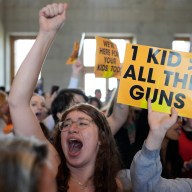 New York City Mayor Michael Bloomberg exits after a speech to the Real Estate Board of New York on May 30, 2013.
New York City Mayor Michael Bloomberg exits after a speech to the Real Estate Board of New York on May 30, 2013.
Credit: Reuters
As Mayor Michael Bloomberg’s 12 years leading New York City come to a close, Metro takes a look at the things he will be remembered for, and the people he will be remembered by.
1. Stop-and-Frisk/Public Safety
For many black and Latino youth, the Bloomberg years will mean a time when they felt under siege for no other reason than the color of their skin, targeted disproportionately by a controversial police practice known as stop-and-frisk.
Stop-and-frisk became an increasingly high profile issue during Bloomberg’s last year. A federal judge ruled that the way the NYPD carries it out is unconstitutional and called for a federal monitor to supervise reforms to the practice.
The city fought that order and was able to get it stayed — an appeal is scheduled to be heard in March, though Mayor-elect Bill de Blasio has said he will drop the appeal.
Bloomberg also fought with the City Council over stop-and-frisk and the Community Safety Act, which included two laws expanding the public’s ability to sue the NYPD for profiling based on criteria other than race (gender, sexuality, immigration or housing status, among others), and a law establishing an Inspector General with oversight of the NYPD beyond simply stop-and-frisk.
While opponents of the practice decried the whopping five million stops conducted over the last decade, the Bloomberg administration has credited stop-and-frisk with the seizure of 8,000 guns. Those weapons, it should be noted, were not necessarily all confiscated during stops — that figure is the total number of guns recovered in the last 10 years, including those discarded by fleeing suspects or left at the scene of a crime.
But Bloomberg often insisted that there was no way to measure the efficacy of stop-and-frisk in dissuading people from carrying guns to begin with.Earlier this year, he touted wiretap audio from amassive interstate gun-trafficking bust as evidence of just that: The trafficker reportedly told one of the undercover agents that he couldn’t bring the guns through Brownsville because of stop-and-frisk.
According to the Bloomberg administration, the NYPD under his watch has brought homicides and gun violence down to record lows. As of Dec. 22 the city saw 45 fewer gun deaths this year than over the same time period last year, a decrease of more than 19 percent.
Bloomberg and Police Commissioner Ray Kelly insisted stop-and-frisk was ultimately for the good of the very youths they were frisking.
Eugene O’Donnell, a police studies professor at John Jay College and a former cop himself, said that while he didn’t agree with everything Kelly’s NYPD did with stop-and-frisk, the fact that lives have been saved — and that the lives saved were those of young black and Latino men — is indisputable.
“To be able to say that several thousand minority kids are not dead, that is a big deal,” O’Donnell said. “Thousands of people that would have been dead are alive today because the murder rate has plummeted to a degree that no one would have predicted.”
2. Gun Control
It is often said that no other mayor has done as much on a national scale as ours, in particular with his battle for better gun regulations nationwide.
The organization he founded with Boston Mayor Tom Menino, Mayors Against Illegal Guns, grew from 15 mayors seven years ago to more than 1,000 now. Their work was so aggressive that the National Rifle Association put out ads specifically attacking the mayor of one Northeastern city.
Whether he beat them or not, our mayor, who frequently and self-deprecatingly notes that he’s a short, Jewish man in his 70s, caught the ire of a national organization that boasts some four million members across the country — and stood his ground.
3. The ‘Ground Zero Mosque’
Some have dismissed the mayor’s apparent disregard for special interest groups as a luxury granted by his personal wealth.
But many of his staffers speak reverently of a specific time when their leader’s outspokenness for what is right left him standing almost alone against what was popular.
When the controversy over a potential mosque being built near Ground Zero raged, one staffer noted that the mayor spoke out in defense of the mosque “when pretty much every Democrat in this town ran and hid.”
“I was very proud to work here at that moment,” the staffer said.
“He was really the only person who was willing to defend the right of people to engage in religious worship where they chose at a time when that was obviously not a very popular move,” Deputy Mayor Howard Wolfson agreed. “That would be, for me, the proudest moment.”
4. Health Initiatives
The mayor has been mockingly labeled “Nanny Bloomberg” at times for health initiatives some have derided as an excessive intrusion into people’s personal lives.
But his smoking ban caught on worldwide, and businesses across the nation now prominently display calorie counts.
His large soda ban was ultimately overturned in court, but at a recent press conference the mayor said he still doesn’t consider the ban a failure — it sparked a conversation, he said, that if nothing else will make some people think twice about the amount of sugar they consume.
5. Education
While the mayor took heat for the very public catastrophic failure of his appointee Cathie Black as schools chancellor, it is almost universally agreed that the mayor’s decision to bring the city’s school system under mayoral control resulted in greater accountability and less bureaucracy, improving public schools to a degree that had previously not been imagined.
NYU professor of urban policy and planning Mitchell Moss said the difference between city schools 12 years ago and city schools today is a fundamental societal shift: Before Michael Bloomberg’s tenure, we didn’t expect public schools to be good — now we demand it.
“We no longer have low expectations of our schools,” Moss said. “There’s now a widespread culture in which we expect schools to educate people and for our kids to graduate.”
6. Sustainability
The Bloomberg administration has approached “greening” the city with the data-driven zeal the mayor is known for — initiatives that have even changed the air we breathe.
Adam Freed,a former Bloomberg administration official who now leads a global water program, spoke proudly of an environmental initiative that he said rivaled the Smoke-Free Air Act in its health impact.
When a study showed the vast majority of controllable air pollution came not from traffic but from heating oil used by some 10,000 of the city’s buildings, the mayor worked with the state legislature and the City Council to enact laws that phased out oil and created financing packages to enable building owners to make the switch, and coordinated with Con Edison and National Grid to build up a reliable natural gas infrastructure, Freed said.
While sustainability has certainly gained national, and even international, popularity in recent years, Freed insisted the city, and the mayor, have led the charge.
As early as 2007, the mayor’s office was assessing the city’s future with an eye to managing population growth and the effects of climate change on an area with hundreds of miles of coastline. PlaNYC was developed, and the city embarked on a goal to reduce greenhouse gas emissions by 30 percent by 2030. City officials say they’re already more than halfway to meeting that goal.
Freed noted that it wasn’t until Sandy that many politicians were willing to unequivocally talk about climate change as a scientific truth. But the mayor “was not a convert to this.”
“He testified in Congress, he was a proponent of the carbon tax,” Freed said. “He was very outspoken. And now, this election cycle, it wasn’t a question of if you had a sustainability agenda, but what it was.”
7. Innovation and Public/Private Partnerships
Bloomberg has been an innovative mayor: From Boro Taxis and Citi Bike to public-private partnerships, he has been a leader of big ideas and new initiatives.
His ability to leverage the private sector to fund public projects has drawn some criticism. While the parks managed by trusts — Friends of the High Line, Brooklyn Bridge Trust, Hudson River Park Trusts — benefit from additional funding for high quality maintenance, some complain it creates a two-tiered system, as most city parks don’t have the same level of operations and maintenance funding.
“[The High Line] sounded like a good idea as an urban planner,” said Susan Turner-Meiklejohn, an urban planning professor at Hunter College. “You take an industrial artifact and you find a new use for it.”
But she lamented the fact that there are “70 maintenance people for the High Line, and 17 for Flushing Park,” saying the outer boroughs get shafted in the public-private partnership game.
“Queens does not have panache,” she said dryly.
But the mayor has also used his finance smarts – and his own wealth, through Bloomberg Philanthropies — to fund anti-recidivism programs and projects like Young Men’s Initiative, a city program geared at young men of color.
New York City was, under Bloomberg, the first city in the nation to experiment with “social issue bonds” — inviting the finance industry to invest in new city initiatives.
If the initiative succeeded, the investor would get a return on the investment. The city would also benefit from its success financially, as the investor would only receive a portion of the money saved, not its entirety.
If the initiative failed, the investor would get nothing — and the city would lose nothing.
Goldman Sachs took on this experiment about a year and a half ago, with a program out of the Young Men’s Initiative called the Adolescent Behavioral Learning Experience.
The program, intended to teach critical thinking and decision-making skills considered vital to successful release and re-entry, was to be implemented in school on Rikers Island. It was funded by a loan from Goldman and a grant from Bloomberg Philanthropies.
At the time, nearly 50 percent of adolescents who left the Department of Correction returned within one year. For Goldman Sachs to break even on its original investment, the program must reduce reincarceration by 10 percent annually.
The program is slated to continue into the next administration.
8. Economic Growth
The billionaire mayor who managed to keep the city from crumbling under two major economic hits — 9/11 and the 2008 financial crisis — did so with three major things: jobs, tourism and development.
When the financial industry collapsed, Moss pointed out, New York’s job market didn’t.In fact, Moss said, “The economy of New York is stronger, because we have more sources of growth.”
Bloomberg energized formerly dormant industries like technology and media, Moss said, turning the city into a leading center for new tech companies, film and production.
Growing entirely new industries “helped New York weather the decline of jobs in finance,” Moss said.
The mayor also created incentives to bring in unprecedented numbers of tourists.
“More visitors come to New York than any other city in America,” Moss said, hailing tourism as “an important job generator,” particularly for entry-level positions.
He also enabled the development of areas that were previously uninhabitable — waterfront warehouse districts like Greenpoint, for example.
And he proved wrong concerns that after 9/11, no one would want to live downtown. Since Sept. 11, 2001, the residential population in that area has doubled.
“Lower Manhattan has been rejuvenated,” Moss said.
But his support for development has also been criticized, often by the people living in neighborhoods changed by Bloomberg’s tax credits and incentives to build luxury condos.
“There were very clear policy decisions that encouraged the building of things for a very upper class population and to the detriment of poor people,” Turner-Meiklejohn said.
9. Homelessness
A dark mark on Bloomberg’s legacy is without question his administration’s record on homelessness.
A recent five-part series in the New York Times on a homeless girl named Dasani shone a spotlight on the apparent failures of the Bloomberg administration to care for the city’s most vulnerable.
Dasani’s story brought heavy criticism down on the mayor, prompting dismissive-sounding responses upon questioning as he insisted her situation was atypical.
“This kid was dealt a bad hand,” the mayor said at the unveiling of a new ice-skating rink in Brooklyn. “I don’t know quite why. That’s just the way God works. Sometimes some of us are lucky and some of us are not.”
The Dasani series and the mayor’s response to it caused the tense relationship between the city and the Coalition for the Homeless to escalate into open hostility, complete with indignant exclamation points and emphatic capitalization.
Wolfson and Deputy Mayor Linda Gibbs, who oversees the city’s agencies for the homeless, took to the pages of the Wall Street Journal to respond — a publication, one person dryly noted, with a real estate section called “Mansion.”
There are facts that cannot be disputed: The city’s homeless population is at record highs.
But the path by which the city got to these record high numbers is murky at best.
The administration will point to the loss of the Advantage program, a rent-subsidy program that was supported by federal, state and city dollars. They blame advocates in part for its loss, asserting that their criticism of it contributed to its demise.
But advocates will say it was due to growing flaws in the program.
The subsidy was guaranteed for one year, with a possibility to renew for a second year if the applicant met certain criteria. But Legal Aid Society attorney Joshua Goldfein said the criteria became harder and harder to meet.
Applicants also started having to pay a greater portion of the rent. Fewer people qualified, and fewer people were able to renew their leases.
Fearing tenants wouldn’t last more than a year, landlords didn’t want to take part in the program.
Because landlords didn’t want to use it, the usage of the program was projected to decline. This is why, advocates say, the state opted to budget less money for the program that year.
And then — Goldfein and a Bloomberg administration official used the same language — the mayor went crazy. Furious, he demanded the state budget the full amount, or the whole program would be shut down.
For advocates, this was the ultimate Bloombergian tantrum. If he couldn’t have it exactly his way, no one would get anything.
But according to the administration, this was the ultimate Bloombergian pragmatism. The program could not work unless the state budgeted the full amount, in part because the state had to put up a certain amount in order to get federal funding as well.
Goldfein said the state legislature offered to put the full amount of funding back into the budget if the city would agree to use federal Section 8 housing subsidies and the New York City Housing Authority for homeless families, which would be cheaper for the state.
The mayor apparently rejected that offer.
“The mayor said, ‘No, it’s not worth it to me,'” Goldfein said.
But the mayor didn’t say that — at least not according to his staff.
An administration official explained that with the waiting list for Section 8 and NYCHA at nearly 250,000 combined, adding even more people would overburden the system beyond reason. Furthermore, Section 8 funding — and all federal funding — is fickle at best, and can’t be relied on consistently.
Goldfein disagreed.
“[Section 8] are the subsidies that are proven to work the best,” he said. “If you measure the outcome, they are the people who come back to shelter the least.”
“Measuring the outcome” sounds like the most Bloombergian of approaches: Follow the data. And the data is there, though complicated by an unfortunate number of unpredictable or difficult to measure variables.
The Coalition has meticulous charts and graphs tracking the relative rise and fall of the homeless population and assistance in relationship to various policy changes over the last few decades.
But the administration accuses the Coalition of ignoring crucial external factors — for example, the volatility of federal funding, or the relative strength of the economy and job market at the time that homeless numbers were low versus when they started to rise.
In fact, there was a time during the administration’s first term when it was far exceeding the progress any previous administration had made in securing housing for the homeless.
According to Goldfein, Mayor Rudy Giuliani “did a reasonably good job of it, but Bloomberg perfected it.”
“They had the greatest success of any administration ever,” Goldfein said. “That is why it was so frustrating.”
This administration’s efficiency at connecting people with subsidies, helping them find apartments, moving families out of shelters and speeding up the NYCHA application process was unparalleled.
“They were the gold standard,” Goldfein said. “And then they just turned around and said, ‘We’re not doing that anymore.'”
“For whatever reason,” Goldfein added, “they adopted this seemingly ideologically motivated rhetoric that if you give people help, they will ask for more.”
Advocates suggest there was something fundamental to Bloomberg’s managerial style and ethos that influenced the administration’s seemingly dispassionate approach to homelessness.
“He is a manager who delegates,” Goldfein said, speculating that there were initiatives the mayor chose to be more and less hands-on with depending on his personal feelings. “These are not issues that he was at all passionate about, it wasn’t something that he was interested in.”
But it can’t be said that the mayor simply didn’t care about the homeless: Early on, he had gone out on a limb and charged Deputy Mayor Linda Gibbs with reducing the shelter population by 60 percent over five years.
“I don’t think anyone would say that it was their goal to make everyone miserable and create all of these dead end programs,” Goldfein said. “But there was something about the way that City Hall functioned that made it impossible for them to admit defeat.”
10. Compassion
Bloomberg received an award this year from the Police and Fire Widows’ Fund, an organization that supports the families of service members killed in the line of duty.
Parents who lost children spoke of Bloomberg as an uncharacteristic paragon of compassion and comfort. He apparently insisted that he be woken up in the middle of the night, if necessary, to be at the hospital if a cop or firefighter had been wounded or killed.
When he accepted the award, the mayor described how he thought he was “ready for anything” when he first took office: Between his business acumen, leadership skills and the knowledge he’d gained of city issues, there was nothing he couldn’t handle.
“But what I don’t think anybody can really get ready for is the moment in a mayor’s job when you get that call,” he explained. “Typically in the middle of the night, that a firefighter or a police officer has been gravely wounded. And you rush to the hospital, and you hope and pray that the person makes it.”
But sometimes they don’t, the mayor said.
“And then you meet their family, a parent or spouse or child, and you have to tell them the worst news that a person can convey to anybody else,” he said.
It’s a responsibility that he said was impossible to grow accustomed to. But from the very first time he met a young man’s grieving parents at a hospital, he has felt it was perhaps his most important and meaningful responsibility as mayor.
He confided to a roomful of New Yorkers who had lost loved ones in the line of duty how it always felt personal.
“I always look at my kids and wonder what would I do if it was my child,” he said. “I’ve never been able to give a eulogy — if it’s a son or a daughter or something — I always choke up.”
11. Management Style
The mayor has been alternately praised and criticized for his reconfiguring of the mayor’s office into what is known as his “bullpen,” a sort of corporate-style labyrinth of cubicles notable for the position of its leader: The mayor sits at a desk the same size as everyone else’s, holding high-level meetings in full sight and earshot of the entire staff.
He will also undoubtedly be remembered by the people who populated that bullpen: his fiercely loyal staff.
At a recent press event a reporter asked off-handedly if a staffer would consider a job in the new mayor’s administration.The reporter had not gotten past the first syllable of the new mayor’s name before the staffer responded firmly in the negative.
This reaction was not uncommon.
And the mayor has a reputation for being protective and supportive of his staff. In fact, Goldfein blamed the mayor’s “refusal to ever admit he made a mistake” with the homeless policy on his allegiance to his deputy.
“He loved Linda Gibbs,” Goldfein said. “And he was willing to back her up on anything, so no matter what happened he came to her defense.”
“His view was: ‘Linda can do no wrong.'”
When asked recently what achievements he was most proud of, the mayor demurred.
“I’d love to tell you they were all my ideas,” he said at the unveiling of the upcoming 7 train extension. But instead he named, and credited, the people who populated his administration: Gibbs, for one, as well as “[Joel] Klein and Dennis [Walcott] in education,” among others.
“My job is to attract great people,” he said, “and to support them when everybody’s critical of them, and to get them to work together.”
12. Spanish
The mayor’s oft-mocked efforts to summarize speeches at public appearances in Spanish spawned a popular Twitter account, @ElBloombito.
But the sometimes sarcastic mayor’s earnest commitment to learning the language earned him appreciation from some who see it as a show of bravery and respect.
Noting the mayor’s commitment to delivering announcements in Spanish especially in times of stress, as in the aftermath of Hurricane Sandy, columnist Esther J. Cepeda wrote, “I happen to love his syntactically bizarre, monotone, yet earnestly delivered Spanish. … Bloomberg’s Spanish is lovely for what it is: a welcome show of respeto.”
Follow Danielle Tcholakian on Twitter @danielleiat
















